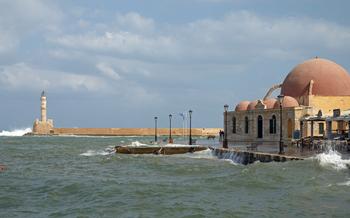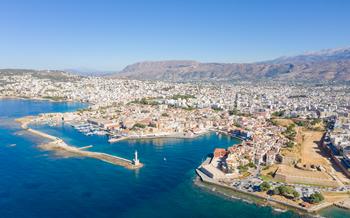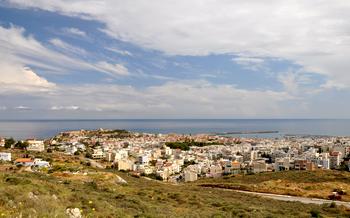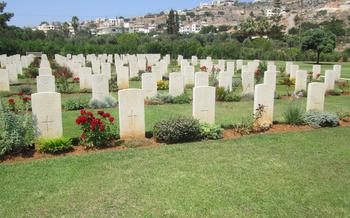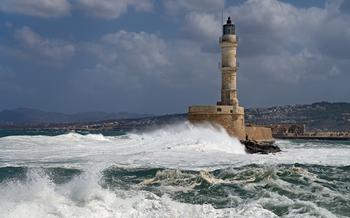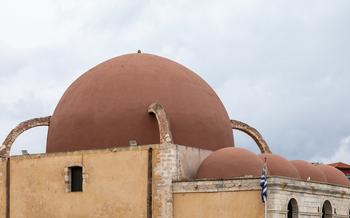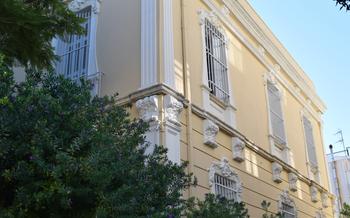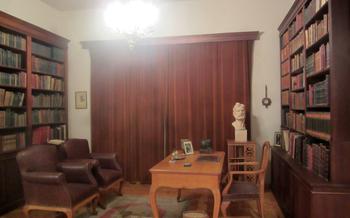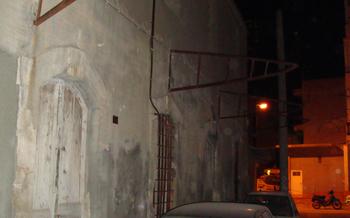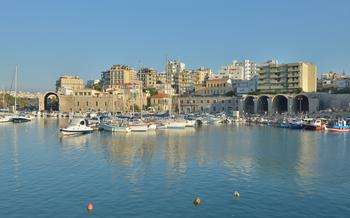
Anogeia War Memorial
- The Anogeia War Memorial: A Tribute to Cretan Resistance
- Honoring the Heroes of World War II
- Exploring the Memorial's Surroundings
- Paying Respects and Remembering
- Learning from the Past: Lessons of Resilience
- Personal Reflections on Visiting the Memorial
- Guided Tours and Local Insights
- Preservation Efforts and Memorial Maintenance
- Respecting Local Customs and Traditions
- Etiquette in Anogeia
- Photography and Social Media
- Planning Your Visit: Practical Considerations
- Additional Resources for Learning
- Inspiring Stories of Resistance
- Insider Tip: Hidden Gems of Anogeia
The Anogeia War Memorial: A Tribute to Cretan Resistance
A Symbol of Honor and Remembrance:
The Anogeia War Memorial stands as a solemn tribute to the brave men and women of Anogeia who fought and sacrificed their lives during World War II. Erected in the heart of the village, this poignant memorial serves as a constant reminder of the indomitable spirit of the Cretan people and their unwavering resistance against foreign occupation.
Situated on a hilltop overlooking the village, the memorial offers a serene and contemplative setting for visitors to pay their respects and honor the fallen heroes. Its poignant design, featuring a series of marble columns and bronze plaques, evokes a sense of reverence and solemnity, inviting visitors to reflect on the sacrifices made during this tumultuous period in history.
Honoring the Heroes of World War II
Anogeia played a pivotal role in the Cretan resistance against the German occupation during World War II. The village served as a refuge for Allied soldiers and a base for guerrilla operations against the enemy. The people of Anogeia demonstrated extraordinary bravery and sacrifice in their fight for freedom.
Among the most notable stories of heroism is that of Captain Manolis Bandouvas, a local resistance leader who led a fierce battle against the Germans in the village square. Despite being outnumbered and outgunned, Bandouvas and his men fought valiantly, inflicting heavy losses on the enemy before being forced to retreat. Bandouvas's courage and leadership earned him the respect of both his comrades and the enemy.
Another inspiring story is that of Maria Psaroulaki, a young woman who risked her life to save Allied soldiers. Psaroulaki hid British and New Zealand soldiers in her home, providing them with food, shelter, and medical care. She also helped to transport soldiers to safety, often using her own donkey to carry them through the mountains. Psaroulaki's bravery and compassion earned her the title of "the Angel of Anogeia."
The Anogeia War Memorial honors the memory of all those who fought and died in the Cretan resistance. The memorial features the names and inscriptions of fallen soldiers, as well as an eternal flame that symbolizes the indomitable spirit of the Cretan people. It serves as a reminder of the sacrifices made by ordinary people in the face of tyranny and oppression.
Exploring the Memorial's Surroundings
The Anogeia War Memorial is nestled amidst the breathtaking scenery of the Psiloritis Mountains, offering panoramic views that will take your breath away. As you stand at the memorial, let your gaze wander across the rugged peaks, lush valleys, and traditional Cretan villages that dot the landscape.
Take a break from the somber atmosphere of the memorial and embark on a leisurely walk through the picturesque village of Anogeia. Admire the traditional architecture, with its whitewashed houses and narrow cobblestone streets. Interact with the friendly locals, who are always eager to share stories and offer recommendations.
For those seeking a more active experience, the area surrounding the memorial offers a variety of hiking trails and nature walks. Immerse yourself in the beauty of the Cretan countryside as you traverse through olive groves, vineyards, and fragrant pine forests. Along the way, you may encounter shepherds tending their flocks, providing a glimpse into the traditional way of life in this region.
After your exploration, indulge in the culinary delights of Crete at one of the many tavernas in Anogeia. Savor the flavors of traditional dishes, such as "dakos" (a Cretan salad with barley rusks), "gamopilafo" (a saffron-infused rice dish), and "kalitsounia" (sweet cheese pastries). As you dine, engage with the locals and learn more about the history, culture, and traditions of this resilient island.
Paying Respects and Remembering
When visiting the Anogeia War Memorial, it is important to observe proper etiquette and protocols to show respect for the fallen heroes and the solemnity of the site. Visitors should maintain a respectful silence while exploring the memorial and refrain from engaging in loud conversations or disruptive behavior. It is customary to lay wreaths or flowers at the memorial as a gesture of remembrance and honor. Visitors are also encouraged to observe moments of silence and reflection, taking time to contemplate the sacrifices made by the brave men and women who fought for freedom during World War II. By showing respect and paying tribute to the fallen, visitors can help preserve the memory of their heroic deeds and honor their legacy for generations to come.
Learning from the Past: Lessons of Resilience
The Anogeia War Memorial stands as a testament to the indomitable spirit of the Cretan people. Their unwavering resilience in the face of adversity serves as a powerful lesson for us all. The memorial reminds us of the value of unity and collaboration, as the Cretans stood together against a formidable enemy. It underscores the importance of preserving cultural heritage and fighting for freedom and independence, values that should never be taken for granted.
This memorial is a poignant reminder of the sacrifices made during wartime and the importance of peace and reconciliation. It invites us to reflect on the consequences of war and the need to work towards a more peaceful future. The lessons learned from the Cretan resistance can inspire us to build a world where conflicts are resolved through dialogue and diplomacy, rather than violence and destruction.
Personal Reflections on Visiting the Memorial
Visiting the Anogeia War Memorial was a deeply moving and humbling experience. The atmosphere was one of profound respect and remembrance, as visitors from around the world paid tribute to the fallen heroes of World War II. The sight of the eternal flame flickering against the backdrop of the majestic Psiloritis Mountains evoked a sense of awe and gratitude.
As I stood there, contemplating the sacrifices made by these brave men and women, I couldn't help but be overwhelmed with emotions. The stories of their courage, resilience, and unwavering commitment to freedom were both inspiring and heartbreaking. Each name inscribed on the memorial represented a life cut short, a family left grieving, and a community forever changed.
The memorial served as a powerful reminder of the horrors of war and the devastating impact it has on individuals, families, and entire nations. It also highlighted the indomitable spirit of the Cretan people, who, despite facing overwhelming odds, never surrendered their fight for freedom and independence.
Visiting the Anogeia War Memorial was a profoundly impactful experience that left me with a renewed appreciation for the value of peace and the importance of remembering the sacrifices made by those who fought for our freedom. It was a reminder that we must never take our liberty for granted and that we must always stand up against tyranny and oppression, no matter the cost.
Guided Tours and Local Insights
For a deeper understanding of the Anogeia War Memorial and its significance, consider booking a guided tour. Knowledgeable local guides can provide historical context, share stories of bravery, and point out details that might otherwise go unnoticed. They can also offer insights into the culture and traditions of Anogeia and the surrounding region.
Guided tours typically cover the history of the memorial, the role of Anogeia in the Cretan resistance, and the stories of the fallen soldiers. Guides may also share personal anecdotes and experiences, providing a unique perspective on the memorial's significance.
Whether you're a history buff, a student, or simply someone interested in learning more about Crete's wartime past, a guided tour can greatly enhance your visit to the Anogeia War Memorial. Local guides can bring the memorial to life, helping you to connect with the sacrifices made by the Cretan people during World War II.
Preservation Efforts and Memorial Maintenance
The Anogeia War Memorial stands as a testament to the resilience and sacrifice of the Cretan people during World War II. Preserving and maintaining this sacred site is of utmost importance to honor the fallen heroes and ensure that their legacy lives on for generations to come.
Local authorities and the community play a crucial role in safeguarding the memorial. Regular maintenance and upkeep tasks are carried out to keep the site in pristine condition. The memorial's surroundings are meticulously landscaped, with native plants and flowers adorning the area to create a serene and respectful atmosphere.
Beyond physical preservation, efforts are also made to preserve the historical significance of the memorial through educational initiatives and outreach programs. Guided tours and workshops are organized to educate visitors about the events that led to the memorial's creation, as well as the stories of bravery and sacrifice associated with it.
The preservation of the Anogeia War Memorial is not just about maintaining a physical structure but also about keeping the memory of those who fought and died for freedom alive. Through ongoing efforts, the memorial continues to serve as a powerful reminder of the indomitable spirit of the Cretan people and the importance of preserving our cultural heritage.
Respecting Local Customs and Traditions
As you explore Anogeia and its surroundings, it's essential to be mindful of local customs and traditions to ensure a respectful and enriching experience. Dress modestly and avoid wearing revealing clothing, especially when visiting religious sites or conservative areas. When interacting with locals, greet them with a warm "kalimera" (good morning) or "kalispera" (good evening) and maintain eye contact as a sign of respect.
Support the local economy by patronizing small businesses, such as family-run tavernas, shops, and boutiques. This helps preserve traditional livelihoods and contributes to the community's well-being. Remember that haggling is not customary in Greece, so be prepared to pay the listed prices.
Etiquette in Anogeia
- Dress modestly and avoid revealing clothing.
- Greet locals with a warm "kalimera" or "kalispera."
- Maintain eye contact when interacting with locals.
- Support the local economy by patronizing small businesses.
- Be mindful of local customs and traditions.
- Respect the privacy of locals and avoid taking their photos without permission.
- Learn a few basic Greek phrases to show your respect for the local culture.
Photography and Social Media
When visiting the Anogeia War Memorial, it is important to be respectful and mindful of the solemnity of the site. Photography is allowed, but visitors should refrain from taking intrusive or disrespectful photos. Avoid posing or taking selfies in front of the memorial, and always ask permission before photographing individuals or groups.
Social media can be a powerful tool for raising awareness about the memorial and sharing stories about the fallen soldiers. However, it is crucial to do so in a responsible and ethical manner. When sharing photos or stories on social media, always remember to credit the memorial and provide accurate information about its history and significance. Avoid using hashtags or captions that are disrespectful or sensationalist, and be mindful of the privacy of individuals depicted in your photos.
By following these guidelines, you can help to ensure that the Anogeia War Memorial remains a place of remembrance and reflection, while also sharing its important story with the world.
Planning Your Visit: Practical Considerations
Visiting the Anogeia War Memorial is a meaningful and enriching experience. To make the most of your visit, consider these practical tips:
-
Best time to visit: The memorial is open year-round, but the best time to visit is during the spring or fall, when the weather is pleasant and there are fewer crowds.
-
Accessibility: The memorial is accessible to visitors with disabilities, with ramps and designated parking spaces available.
-
Duration of the visit: Allow at least an hour to explore the memorial and its surroundings. You can spend more time if you choose to hike in the nearby mountains or visit the traditional villages.
-
Suggested itineraries: Combine your visit to the memorial with other nearby attractions, such as the Arkadi Monastery, the Museum of the Battle of Crete, or the village of Margarites, known for its pottery.
-
Dress code: Dress respectfully, as the memorial is a sacred site. Avoid wearing shorts or tank tops.
-
Be mindful of the noise: The memorial is a place for quiet reflection, so be mindful of your noise level and avoid talking loudly.
-
Photography: Photography is allowed at the memorial, but be respectful of the privacy of others and avoid using flash photography.
-
Guided tours: Guided tours are available, which can provide valuable insights into the history of the memorial and the Cretan resistance.
-
Local guides: Consider hiring a local guide to gain a deeper understanding of the region's history and culture.
-
Support the local economy: Show your support for the local community by patronizing local businesses, such as tavernas, cafes, and shops.
Additional Resources for Learning
To delve deeper into the history of Crete and the Cretan resistance during World War II, we recommend exploring the following resources:
- Books:
- "The Battle for Crete" by Antony Beevor provides a comprehensive account of the German invasion and the subsequent resistance.
- "Island of War: The Battle for Crete, 1941" by John Keegan offers a detailed analysis of the military strategies and tactics employed during the conflict.
-
"The Cretan Runner" by George Psychoundakis is a fictionalized account of the resistance movement, based on true stories and characters.
-
Documentaries:
- "The Battle for Crete" (1965) is a classic documentary that features interviews with veterans and archival footage of the fighting.
- "Crete: The Last Battle" (2011) is a more recent documentary that explores the role of the local population in the resistance.
-
"The Cretan Resistance" (2014) is a short documentary that provides a concise overview of the events and their significance.
-
Online Resources:
- The website of the Commonwealth War Graves Commission provides information on the war cemeteries and memorials in Crete, including the Anogeia War Memorial.
- The Historical Museum of Crete in Heraklion has a dedicated section on the Cretan resistance, featuring artifacts, documents, and personal stories.
- The website of the University of Crete offers access to academic research papers and articles on the history of Crete during World War II.
Inspiring Stories of Resistance
The Anogeia War Memorial is a poignant reminder of the indomitable spirit of the Cretan people during World War II. Among the many stories of bravery and sacrifice, one that stands out is that of Manolis Paterakis, a local shepherd who played a crucial role in the resistance.
Paterakis, known for his knowledge of the mountainous terrain, served as a guide for Allied soldiers and helped them evade capture by German forces. He risked his life on numerous occasions, leading Allied soldiers through treacherous paths and providing them with food and shelter.
His heroic actions earned him the respect and admiration of the Allied soldiers and the local community. Paterakis' story is a testament to the courage and resilience of the Cretan people, who stood up against oppression and fought for their freedom.
Such stories of individual heroes serve as a reminder of the indomitable spirit of the Cretan resistance. They foster a sense of national pride and inspire future generations to uphold the values of courage, sacrifice, and freedom.
Insider Tip: Hidden Gems of Anogeia
Beyond the Anogeia War Memorial, the village itself is a treasure trove of hidden gems waiting to be discovered. As you wander through its narrow streets and charming alleys, you'll encounter local artisans showcasing their traditional crafts, from intricate pottery to handwoven textiles. Take some time to browse their shops and support their artistry.
Indulge in the authentic flavors of Crete at one of the many tavernas in Anogeia. Savor the mouthwatering dishes prepared with fresh, local ingredients, accompanied by the warm hospitality of the locals. Whether it's the aromatic "dakos" salad, the hearty "stamnagathi" greens, or the succulent grilled meats, the culinary delights of Anogeia will leave you wanting more.
As the sun sets, the village comes alive with a vibrant nightlife and cultural events. Join the locals for traditional Cretan dancing, where the infectious rhythms and energetic steps will have you moving to the beat. Experience the passion and pride of the Cretan people as they celebrate their rich heritage through music and dance.
Remember to interact with the locals and embrace their warm hospitality. Engaging in conversations and learning about their way of life will provide you with a deeper understanding of the Cretan culture and its unique charm. Show your support for the local economy by purchasing handmade souvenirs, dining at local restaurants, and immersing yourself in the authentic experiences that Anogeia has to offer.
